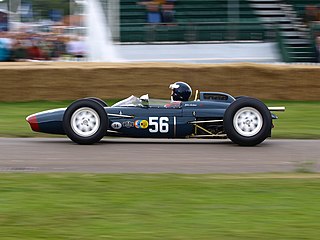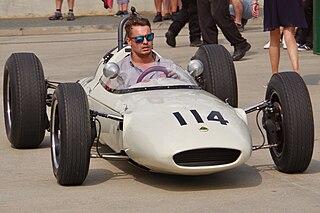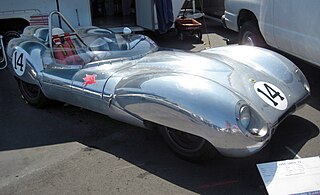
The Cooper Car Company is a car manufacturer founded in December 1947 by Charles Cooper and his son John Cooper. Together with John's boyhood friend, Eric Brandon, they began by building racing cars in Charles's small garage in Surbiton, Surrey, England, in 1946. Through the 1950s and early 1960s they reached motor racing's highest levels as their rear-engined, single-seat cars altered the face of Formula One and the Indianapolis 500, and their Mini Cooper dominated rally racing. Due in part to Cooper's legacy, Great Britain remains the home of a thriving racing industry, and the Cooper name lives on in the Cooper versions of the Mini production cars that are still built in England, but are now owned and marketed by BMW.

Coventry Climax was a British forklift truck, fire pump, racing, and other speciality engine manufacturer.

Repco is an Australian automotive engineering/retailer company. Its name is an abbreviation of Replacement Parts Company and it is best known for spare parts and motor accessories.

JBW Cars was a British racing car manufacturer in the late 1950s, who were a Formula One constructor from 1959 to 1961.

Connaught Engineering, often referred to simply as Connaught, was a Formula One and sports car constructor from the United Kingdom. Their cars participated in 18 Grands Prix, entering a total of 52 races with their A, B, and C Type Formula 2 and Formula 1 Grand Prix Cars. They achieved 1 podium and scored 17 championship points. The name Connaught is a pun on Continental Autos, the garage in Send, Surrey, which specialised in sales and repair of European sports cars such as Bugatti, and where the cars were built.
Shannon Racing Cars was a Formula One constructor from the United Kingdom with Aiden Jones, formerly a mechanic for Prince Bira and Prince Chula, and Paul Emery as the principals. Using a car built by former Emeryson designer Emery and an old Coventry Climax engine, they participated in a single Grand Prix. Trevor Taylor drove for the team at the 1966 British Grand Prix, retiring early in the race. The car was then used for Formula 3 until 1969.

The Lotus 32 was a Formula 2 racing car built by Team Lotus in 1964. It was developed from the Lotus 27 Formula Junior model. Twelve cars were produced, four of which were run by Ron Harris Team Lotus, whose drivers included Jim Clark and Mike Spence. Spence won the 1964 Autocar British Formula 2 Championship while Clark was fourth in the Trophées de France Championship.

A flat-16 is a rarely used internal combustion engine, arranged in two banks of 8 horizontally-opposed cylinders.
Walter Thomas Frederick "Wally" Hassan OBE, C.Eng., M.I. Mech.E. was a distinguished UK automotive engineer who took part in the design and development of three very successful engines: Jaguar XK, Coventry Climax and Jaguar V12, as well as the ERA racing car.
Lee Stroyer was a British petrol engine manufacturing company and a producer of a limited number of cars.

The Lola Mk4 and the derivative Mk4A were Formula One racing cars constructed by the Lola company in 1962. They were designed by Lola founder, owner and Chief Designer Eric Broadley at the request of Reg Parnell, proprietor of the Bowmaker Racing Team. The Mk4 was the first design that Lola produced for the top tier of motorsport.

The Lotus 21 was a Formula One racing car designed by Colin Chapman. It was a mid-engined design using a tubular spaceframe structure skinned with fibreglass panels, of a more advanced build than seen in the Lotus 18. Powered by the 1.5-litre Coventry Climax FPF 4-cylinder engine, it used disc brakes all round.
The Lotus 39 was a single-seat racing car produced by Team Lotus. It was originally intended for use in Formula One, to be powered by the Coventry Climax 1.5 litre flat-16 engine. The engine project fell through and the chassis was modified to accept a Climax 2.5 litre engine for the 1966 Tasman Series, in which Jim Clark finished in third place.

The Lotus 24 was a Formula One racing car designed by Team Lotus for the 1962 Formula One season. Despite some early success in non-Championship Grands Prix, it was eclipsed by the technically superior Lotus 25 and rarely featured in the points in World Championship races.

Warwick Farm Raceway was a motor racing facility which was in operation from 1960 to 1973. Warwick Farm Raceway hosted numerous major events during its life such as the Australian Grand Prix and rounds of both the Australian Touring Car Championship and the Tasman Series.

The Brabham BT3 is a Formula One racing car. It was the first Formula One design to be produced by Motor Racing Developments for the Brabham Racing Organisation, and debuted at the 1962 German Grand Prix. The Brabham BT3 was the vehicle with which team owner – then two-time World Champion – Jack Brabham, became the first driver ever to score World Championship points in a car bearing his own name, at the 1962 United States Grand Prix. The following year Brabham also became the first driver ever to win a Formula One race at the wheel of an eponymous car, again driving the BT3, at the 1963 Solitude Grand Prix. The BT3 design was modified only slightly to form the Tasman Series-specification Brabham BT4 cars.

The Lotus 15 is a front-engine sports racing car designed by Colin Chapman of Lotus, built from 1958 until 1960.

Owen Richard Maddock was a British engineer and racing car designer, who was chief designer for the Cooper Car Company between 1950 and 1963. During this time Maddock designed a string of successful racing cars, including the Formula One World Championship-winning Cooper T51 and T53 models.















